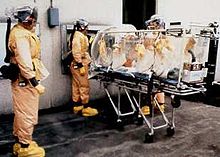Racal suit

A Racal suit (also known as a Racal space suit)
Originally, the hood was manufactured by Racal Health & Safety, a subsidiary of
Components
The hood is a separate component from the protective suit. The Racal hood is a type of PAPR consisting of a transparent hood connected to a respirator, which is powered by a rechargeable battery. The respirator has three HEPA filters that are certified to remove 99.7% of particles of 0.03 to 3.0 microns in diameter. The filtered air is supplied at the rate of 170 L/min to the top of the hood under positive pressure for breathing and cooling. The air is forced out through an air exhaust valve at the base of the hood. A two-way radio system is installed inside the hood for communication.[3][8] The AIT later switched from using transparent bubble hoods to butyl rubber hoods.[6]
Procedures
The main purpose of the AIT was to evacuate a patient from the field to a specialized isolation unit. As part of their procedures, AIT members wore Racal suits while transporting the patients.[
Similar suits
The Racal suit is similar to other
In popular culture
Racal suits were used in films such as Outbreak in 1995.[11] The term is also used in literature related to situations with infectious diseases, such as in The Hot Zone: A Terrifying True Story,[7] Infected,[12] and Executive Orders.[13]
References
- ^ a b c Sidell, Frederick R.; Takafuji, Ernest T.; Franz, David R., D.V.M. (1997). "19". Medical Aspects of Chemical and Biological Warfare. Office of The Surgeon General Department of the Army, United States of America. Archived from the original on 26 April 2005. Retrieved 15 April 2015.
{{cite book}}: CS1 maint: multiple names: authors list (link) - ^ "Racal space suit". McGraw-Hill Concise Dictionary of Modern Medicine. Retrieved 15 April 2015.
- ^ a b "The threat to the United States from Emerging Infectious Diseases, Hearing before the Committee on International Relations, House of Representatives". 30 July 1997: 9. Retrieved 15 April 2015.
{{cite journal}}: Cite journal requires|journal=(help) - ^ a b "Racal Health & Safety to be sold to 3M for GBP432 mil". Telecompaper. No. 5 December 1997. Retrieved 17 April 2015.
- ^ "NIOSH Respirator User Notice". The National Personal Protective Technology Laboratory (NPPTL). 12 June 1998. Retrieved 17 April 2015.
- ^ PMID 12000908.
- ^ ISBN 9780307817655. Retrieved 18 June 2021.
- PMID 10221876. Retrieved 17 April 2015.
- ^ Fleming-Michael, Karen (28 September 2005). "Training Day". Comprint Military Publications. Archived from the original on 20 January 2015. Retrieved 17 April 2015.
- ^ Hamblin, James (26 October 2014). "21 Days". The Atlantic. Retrieved 17 April 2015.
- ^ Day, Kathleen (11 March 1995). "A Clothes Call With Danger". The Washington Post. Retrieved 30 October 2015.
- ISBN 9780307409171. Retrieved 30 October 2015.
- ISBN 9780425158630. Retrieved 30 October 2015.
